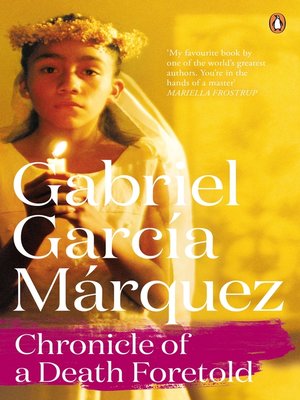

Continue to vary your sentence structure. I nclude at least two examples (each) of evocative imagery and lyrical phrasing. It in the shadows, she found it at first sight among the many, many easily confused names from this world and the other, and she nailed it to the wall with her well-aimed dart, like a butterfly with no will whose sentence has always been written” (47). Pope, “ Illusion and Transparency in Marquez’s A Chronicle of a Death Foretold” Consider how you will add mystery and depth to your event. Mystery and Depth: Marquez adds mystery and depth to his Chronicle through the unopened letters of Angela, the judge’s evocative marginal notes, and his heavy-handed use of foreshadowing. Bold any other sentences that you are particularly proud of. Include at least two examples (each) of evocative imagery and lyrical phrasing. This may be my favorite from the novel: “ only took the time necessary to say the name. Consider how you could do this in your piece.Įvocative Imagery and Lyrical Phrasing: Review some of Marquez’s images and clever phrasing. Lindsay Moore, “In magical realism, the supernatural is not displayed as questionable.” Marquez seems to elevate supernatural elements over rationality, memory over facts. Consider how your character testimony could serve to conceal more than reveal.Ītmospheric Touches – Magical Realism: Marquez incorporates superstition and augery to emphasize the force of fatalism in the novel. In A Chronicle of a Death Foretold, the testimony of the characters is at times contradictory and vague. You should, like Marquez, inform the reader of your event in your opening passage before showing the reader the details in your concluding paragraph.Ĭharacter Testimony – Magical Realism: Create a small cast of characters who will provide (fictional) insight to your event. Narrative Structure: Like a vulture encircling its prey, Marquez’s Chronicle distances itself from the actual murder of Santiago Nasar, choosing rather to symbolically butcher Nasar before allowing us to descend upon his stumbling, disemboweled body. You will need a works cited for any outside research and you must attach a print-out of the article or source to your finished work.Īfter you have zeroed in on an event, think about how you could approach it using some Marquez’s techniques. You may choose any sort of event, but it should be compelling in nature. I ask you to begin in reality because most critics believe that Marquez, himself, was inspired by an actual murder in Sucre, Colombia. I am asking you to use your imagination to add depth and dimension to an actual event.īegin with an actual occurrence, either historical or recent. In the above excerpt, Marquez emphasizes the power of the imagination to transform reality. I would like you to create your own chronicle in the style of Marquez. Pope, “Illusion and Transparency in Marquez’s A Chronicle of a Death Foretold” sooner or later, reality ends up by agreeing with imagination.) This is our first important discovery: for Garcia Marquez, freedom is found in imagination, because there the human being can go beyond history and literature, anticipating it, since eventually whatever is new will end up swallowed up by the discourses of the experienced and the imagined. tarde o temprano, la realidad termina por darle la razon a la imaginacion.” (Remember that the great majority of things in this world, from spoons to heart transplants, were first in the imagination of human beings then in reality. Garcia Marquez has stressed repeatedly the importance imagination has in transforming the world: “Acuerdate que la gran mayoria de las cosas de este mundo, desde las cucharas hasta los transplantes del corazon, estuvieron en la imaginacion de los hombres antes de estar en la realidad.


A Chronicle of a Death Foretold (1981) by Gabriel Garcia Marquez


 0 kommentar(er)
0 kommentar(er)
